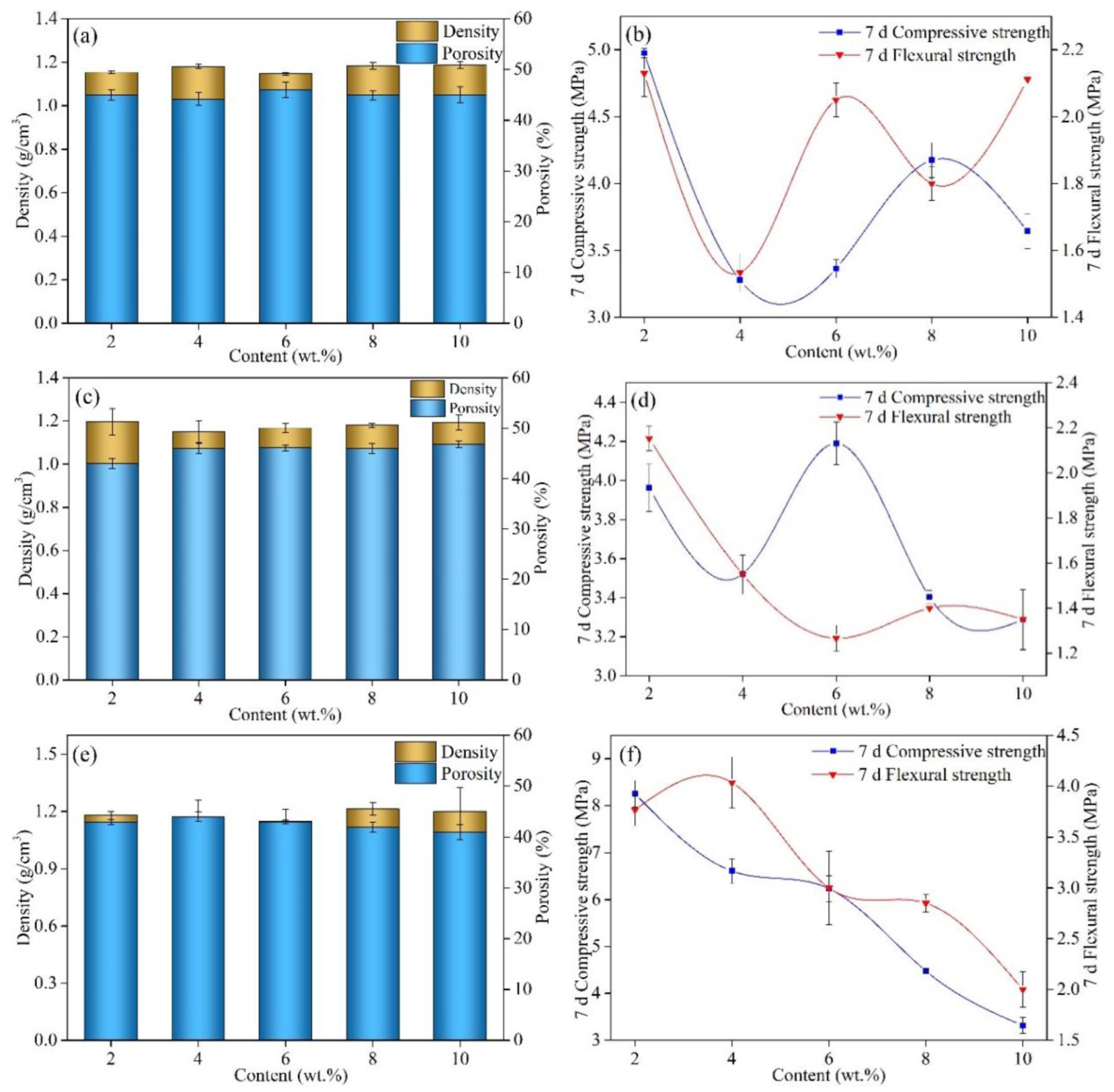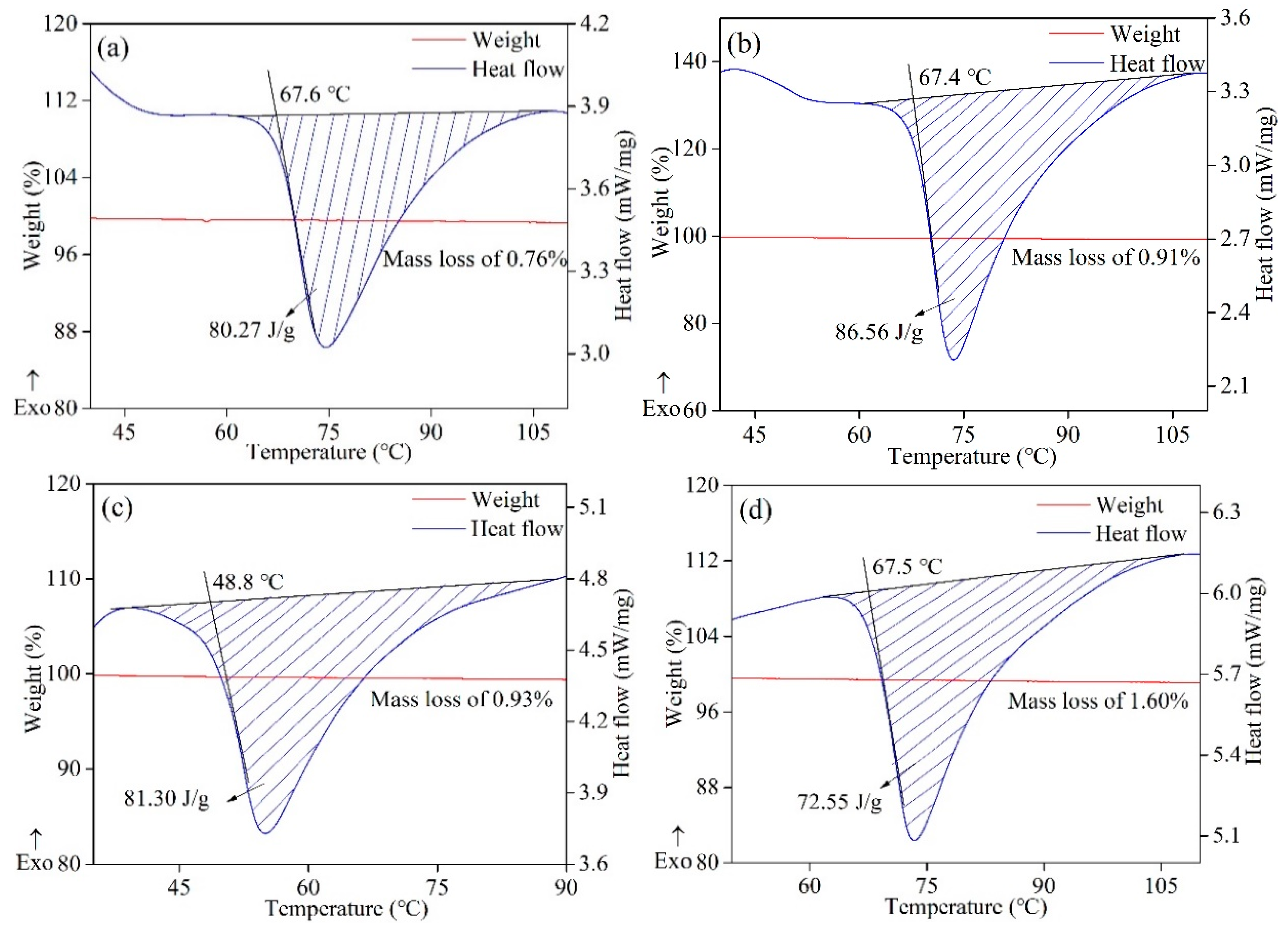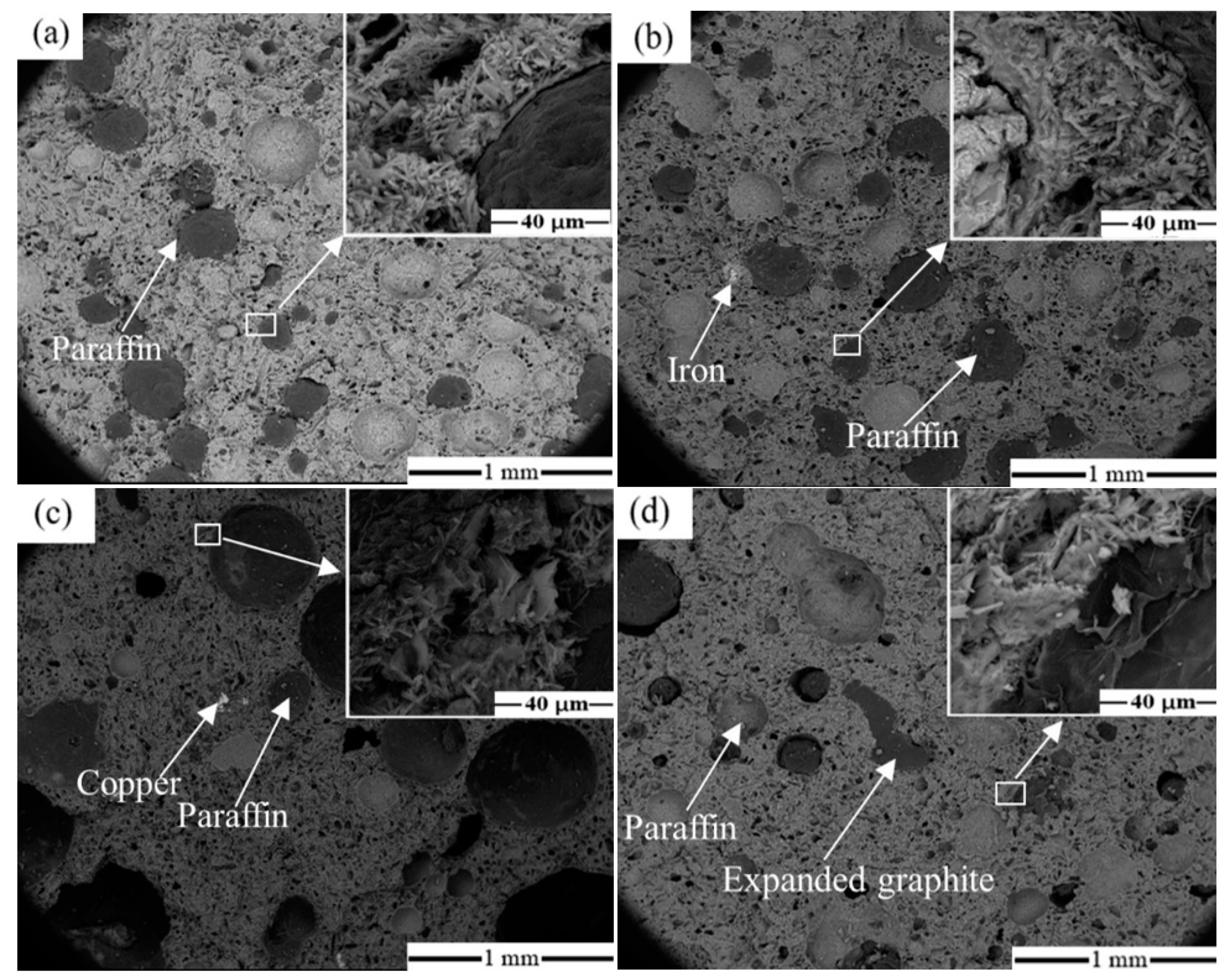Mechanical and Thermal Properties of Thermally Conductive Enhanced Paraffin/Gypsum Composites
Abstract
1. Introduction
2. Materials and Methods
2.1. Raw Materials
2.2. Sample Preparation
2.3. Material Characterization
3. Results and Discussion
3.1. Physical and Mechanical Properties of PA/Gypsum Composites
3.2. Physical and Mechanical Properties of Thermally Conductive Enhanced PA/Gypsum Composites
3.3. Microstructures of the Thermally Conductive Enhanced PA/Gypsum Composites
4. Conclusions
Author Contributions
Funding
Institutional Review Board Statement
Informed Consent Statement
Data Availability Statement
Conflicts of Interest
References
- Marani, A.; Madhkhan, M. Thermal performance of concrete sandwich panels incorporating phase change materials: An experimental study. J. Mater. Res. Technol. 2021, 12, 760–775. [Google Scholar] [CrossRef]
- Chen, X.; Kong, X.; Wang, S.; Fu, X.; Yu, B.; Yao, K.; Zhong, Y.; Li, J.; Xu, W.; Liu, Y. Microencapsulated phase change materials: Facile preparation and application in building energy conservation. J. Energy Storage 2022, 48, 104025. [Google Scholar] [CrossRef]
- Wu, Z.; Qin, M.; Zhang, M. Phase change humidity control material and its impact on building energy consumption. Energy Build. 2018, 174, 254–261. [Google Scholar] [CrossRef]
- Zhang, Y.; Huang, J.; Fang, X.; Ling, Z.; Zhang, Z. Optimal roof structure with multilayer cooling function materials for building energy saving. Int. J. Energy Res. 2020, 44, 1594–1606. [Google Scholar] [CrossRef]
- Al-Yasiri, Q.; Szabó, M. Incorporation of phase change materials into building envelope for thermal comfort and energy saving: A comprehensive analysis. J. Build. Eng. 2021, 36, 102122. [Google Scholar] [CrossRef]
- Lauermannová, A.M.; Pavlíková, M.; Pavlík, Z.; Pivák, A.; Jiříčková, A.; Sklenka, J.; Záleská, M.; Růžička, K.; Jankovský, O. Magnesium oxychloride cement with phase change material: Novel environmentally-friendly composites for heat storage. J. Mater. Res. Technol. 2022, 21, 3327–3342. [Google Scholar] [CrossRef]
- Sage-Lauck, J.S.; Sailor, D.J. Evaluation of phase change materials for improving thermal comfort in a super-insulated residential building. Energy Build. 2014, 79, 32–40. [Google Scholar] [CrossRef]
- Figueiredo, A.; Vicente, R.; Lapa, J.; Cardoso, C.; Rodrigues, F.; Kämpf, J. Indoor thermal comfort assessment using different constructive solutions incorporating PCM. Appl. Energy 2017, 208, 1208–1221. [Google Scholar] [CrossRef]
- Sovetova, M.; Memon, S.A.; Kim, J. Thermal performance and energy efficiency of building integrated with PCMs in hot desert climate region. Sol. Energy 2019, 189, 357–371. [Google Scholar] [CrossRef]
- Zhou, D.; Zhao, C.Y.; Tian, Y. Review on thermal energy storage with phase change materials (PCMs) in building applications. Appl. Energy 2012, 95, 593–605. [Google Scholar] [CrossRef]
- Zhu, N.; Ma, Z.; Wang, S. Dynamic characteristics and energy performance of buildings using phase change materials: A review. Energy Convers. Manag. 2009, 50, 3169–3181. [Google Scholar] [CrossRef]
- Jamekhorshid, A.; Sadrameli, S.M.; Farid, M. A review of microencapsulation methods of phase change materials (PCMs) as a thermal energy storage (TES) medium. Renew. Sustain. Energy Rev. 2014, 31, 531–542. [Google Scholar] [CrossRef]
- Nazir, H.; Batool, M.; Osorio, F.J.B.; Isaza-Ruiz, M.; Xu, X.; Vignarooban, K.; Phelan, P.; Inamuddin Kannan, A.M. Recent developments in phase change materials for energy storage applications: A review. Int. J. Heat Mass Transf. 2019, 129, 491–523. [Google Scholar] [CrossRef]
- Kenisarin, M.; Mahkamov, K. Salt hydrates as latent heat storage materials: Thermophysical properties and costs. Sol. Energy Mater. Sol. C 2016, 145, 255–286. [Google Scholar] [CrossRef]
- Yuan, Y.; Zhang, N.; Tao, W.; Cao, X.; He, Y. Fatty acids as phase change materials: A review. Renew. Sustain. Energy Rev. 2014, 29, 482–498. [Google Scholar] [CrossRef]
- Lashgari, S.; Arabi, H.; Mahdavian, A.R.; Ambrogi, V. Thermal and morphological studies on novel PCM microcapsules containing n-hexadecane as the core in a flexible shell. Appl. Energy 2017, 190, 612–622. [Google Scholar] [CrossRef]
- Ao, C.; Yan, S.; Zhao, S.; Hu, W.; Zhao, L.; Wu, Y. Stearic acid/expanded graphite composite phase change material with high thermal conductivity for thermal energy storage. Energy Rep. 2022, 8, 4834–4843. [Google Scholar] [CrossRef]
- Harlé, T.; Hebert, R.L.; Nguyen, G.T.M.; Ledésert, B.A. A composite of cross-linked polyurethane as solid–solid phase change material and plaster for building application. Energy Build. 2022, 262, 111945. [Google Scholar] [CrossRef]
- Ma, F.; Chen, C.; Wang, Y. Mechanical behavior of calcium sulfate whisker-reinforced paraffin/gypsum composites. Constr. Build. Mater. 2021, 305, 124795. [Google Scholar] [CrossRef]
- Gencel, O.; Hekimoglu, G.; Sarı, A.; Ustaoglu, A.; Subasi, S.; Marasli, M.; Erdogmus, E.; Memonh, S.A. Glass fiber reinforced gypsum composites with microencapsulated PCM as novel building thermal energy storage material. Constr. Build. Mater. 2022, 340, 127788. [Google Scholar] [CrossRef]
- Gencel, O.; del Coz Diaz, J.J.; Sutcu, M.; Koksal, F.; Rabanal, F.P.A.; Martinez-Barrera, G.; Brostow, W. Properties of gypsum composites containing vermiculite and polypropylene fibers: Numerical and experimental results. Energy Build. 2014, 70, 135–144. [Google Scholar] [CrossRef]
- Jeong, S.G.; Wi, S.; Chang, S.J.; Lee, J.; Kim, S. An experimental study on applying organic PCMs to gypsum-cement board for improving thermal performance of buildings in different climates. Energy Build. 2019, 190, 183–194. [Google Scholar] [CrossRef]
- Wei, L.; Li, G.; Song, M.; Sun, S. Theoretical investigation on inverse identification of spectral properties of paraffin phase change materials based on multi-thickness model. Sol. Energy 2021, 225, 266–274. [Google Scholar] [CrossRef]
- Cherki, A.; Remy, B.; Khabbazi, A.; Jannot, Y.; Baillis, D. Experimental thermal properties characterization of insulating cork–gypsum composite. Constr. Build. Mater. 2014, 54, 202–209. [Google Scholar] [CrossRef]
- Jegadheeswaran, S.; Pohekar, S.D.; Kousksou, T. Conductivity particles dispersed organic and inorganic phase change materials for solar energy storage an exergy based comparative evaluation. Energy Procedia 2012, 14, 643–648. [Google Scholar] [CrossRef]
- Shukla, A.; Buddhi, D.; Sawhney, R.L. Thermal cycling test of few selected inorganic and organic phase change materials. Renew. Energy 2008, 33, 2606–2614. [Google Scholar] [CrossRef]
- Khodadadi, J.M.; Fan, L.; Babaei, H. Thermal conductivity enhancement of nanostructure-based colloidal suspensions utilized as phase change materials for thermal energy storage: A review. Renew. Sustain. Energy Rev. 2013, 24, 418–444. [Google Scholar] [CrossRef]
- Qureshi, Z.A.; Ali, H.M.; Khushnood, S. Recent advances on thermal conductivity enhancement of phase change materials for energy storage system: A review. Int. J. Heat Mass Transf. 2018, 127, 838–856. [Google Scholar] [CrossRef]
- Wu, S.; Yan, T.; Kuai, Z.; Pan, W. Thermal conductivity enhancement on phase change materials for thermal energy storage: A review. Energy Storage Mater. 2020, 25, 251–295. [Google Scholar] [CrossRef]
- Sarı, A.; Biçer, A.; Hekimoğlu, G. Effects of carbon nanotubes additive on thermal conductivity and thermal energy storage properties of a novel composite phase change material. J. Compos. Mater. 2019, 53, 2967–2980. [Google Scholar] [CrossRef]
- Yang, X.; Yuan, Y.; Zhang, N.; Cao, X.; Liu, C. Preparation and properties of myristic–palmitic–stearic acid/expanded graphite composites as phase change materials for energy storage. Sol. Energy 2014, 99, 259–266. [Google Scholar] [CrossRef]
- Xie, N.; Li, Z.; Gao, X.; Fang, Y.; Zhang, Z. Preparation and performance of modified expanded graphite/eutectic salt composite phase change cold storage material. Int. J. Refrig. 2020, 110, 178–186. [Google Scholar] [CrossRef]
- Zhang, N.; Yuan, Y.; Du, Y.; Cao, X.; Yuan, Y. Preparation and properties of palmitic-stearic acid eutectic mixture/expanded graphite composite as phase change material for energy storage. Energy 2014, 78, 950–956. [Google Scholar] [CrossRef]
- Zhang, Z.; Fang, X. Study on paraffin/expanded graphite composite phase change thermal energy storage material. Energy Convers. Manag. 2006, 47, 303–310. [Google Scholar] [CrossRef]
- Wei, B.; Zhang, L.; Yang, S. Polymer composites with expanded graphite network with superior thermal conductivity and electromagnetic interference shielding performance. Chem. Eng. J. 2021, 404, 126437. [Google Scholar] [CrossRef]
- Wu, S.; Li, T.; Tong, Z.; Chao, J.; Zhai, T. High-performance thermally conductive phase change composites by large-size oriented graphite sheets for scalable thermal energy harvesting. Adv. Mater. 2019, 31, 1905099. [Google Scholar] [CrossRef]
- Li, C.; Zhang, B.; Liu, Q. N-eicosane/expanded graphite as composite phase change materials for electro-driven thermal energy storage. J. Energy Storage 2020, 29, 101339. [Google Scholar] [CrossRef]
- Wang, Q.; Zhou, D.; Chen, Y.; Eames, P.; Wu, Z. Characterization and effects of thermal cycling on the properties of paraffin/expanded graphite composites. Renew. Energy 2020, 147, 1131–1138. [Google Scholar] [CrossRef]
- Wu, S.; Li, T.; Wu, M.; Xu, J.; Hu, Y.; Chao, J.; Yan, T.; Wang, R. Highly thermally conductive and flexible phase change composites enabled by polymer/graphite nanoplatelet-based dual networks for efficient thermal management. J. Mater. Chem. A 2020, 8, 20011–20020. [Google Scholar] [CrossRef]
- Chen, X.; Cheng, P.; Tang, Z.; Xu, X.; Wang, G. Carbon-based composite phase change materials for thermal energy storage, transfer, and conversion. Adv. Sci. 2021, 8, 2001274. [Google Scholar] [CrossRef]
- Wang, Y.; Wang, F.; Zhao, L.; Mao, Z.; Feng, X.; Sui, X.; Wang, B. Shape-stable and fire-resistant hybrid phase change materials with enhanced thermoconductivity for battery cooling. Chem. Eng. J. 2022, 431, 133983. [Google Scholar] [CrossRef]
- Mohamed, N.H.; Soliman, F.S.; El Maghraby, H.; Moustfa, Y.M. Thermal conductivity enhancement of treated petroleum waxes, as phase change material, by α nano alumina: Energy storage. Renew. Sustain. Energy Rev. 2017, 70, 1052–1058. [Google Scholar] [CrossRef]
- Liu, X.; Tie, J.; Wang, Z.; Xia, Y.; Wang, C.; Tie, S. Improved thermal conductivity and stability of Na2SO4·10H2O PCMs system by incorporation of Al/C hybrid nanoparticles. J. Mater. Res. Technol. 2021, 12, 982–988. [Google Scholar] [CrossRef]
- Şahan, N.; Fois, M.; Paksoy, H. Improving thermal conductivity phase change materials—A study of paraffin nanomagnetite composites. Sol. Energy Mater. Sol. Cells 2015, 137, 61–67. [Google Scholar] [CrossRef]
- Goli, P.; Legedza, S.; Dhar, A.; Salgado, R.; Renteria, J.; Balandin, A.A. Graphene-enhanced hybrid phase change materials for thermal management of Li-ion batteries. J. Power Sources 2014, 248, 37–43. [Google Scholar] [CrossRef]
- Cheng, W.; Zhang, R.; Xie, K.; Liu, N.; Wang, J. Heat conduction enhanced shape-stabilized paraffin/HDPE composite PCMs by graphite addition: Preparation and thermal properties. Sol. Energy Mater. Sol. Cells 2010, 94, 1636–1642. [Google Scholar] [CrossRef]
- Zhang, Y.; Tao, W.; Wang, K.; Li, D. Analysis of thermal properties of gypsum materials incorporated with microencapsulated phase change materials based on silica. Renew. Energy 2020, 149, 400–408. [Google Scholar] [CrossRef]





| No. | Gypsum (g) | Paraffin (wt.%) | Water (g) |
|---|---|---|---|
| 1 | 1000 | 5 | Normal consistency water requirement of gypsum |
| 2 | 1000 | 10 | |
| 3 | 1000 | 15 | |
| 4 | 1000 | 20 | |
| 5 | 1000 | 25 |
| TC | Paraffin (wt.%) | Content (wt.%) | ||||
|---|---|---|---|---|---|---|
| Iron powder | The optimum content determined according to Table 1 | 2 | 4 | 6 | 8 | 10 |
| Copper powder | 2 | 4 | 6 | 8 | 10 | |
| EG | 2 | 4 | 6 | 8 | 10 | |
Disclaimer/Publisher’s Note: The statements, opinions and data contained in all publications are solely those of the individual author(s) and contributor(s) and not of MDPI and/or the editor(s). MDPI and/or the editor(s) disclaim responsibility for any injury to people or property resulting from any ideas, methods, instructions or products referred to in the content. |
© 2023 by the authors. Licensee MDPI, Basel, Switzerland. This article is an open access article distributed under the terms and conditions of the Creative Commons Attribution (CC BY) license (https://creativecommons.org/licenses/by/4.0/).
Share and Cite
Chen, C.; Wang, H.; Wang, Y.; Chen, Y.; Jiu, S. Mechanical and Thermal Properties of Thermally Conductive Enhanced Paraffin/Gypsum Composites. Processes 2023, 11, 999. https://doi.org/10.3390/pr11040999
Chen C, Wang H, Wang Y, Chen Y, Jiu S. Mechanical and Thermal Properties of Thermally Conductive Enhanced Paraffin/Gypsum Composites. Processes. 2023; 11(4):999. https://doi.org/10.3390/pr11040999
Chicago/Turabian StyleChen, Chang, Huan Wang, Yubin Wang, Yanxin Chen, and Shaowu Jiu. 2023. "Mechanical and Thermal Properties of Thermally Conductive Enhanced Paraffin/Gypsum Composites" Processes 11, no. 4: 999. https://doi.org/10.3390/pr11040999
APA StyleChen, C., Wang, H., Wang, Y., Chen, Y., & Jiu, S. (2023). Mechanical and Thermal Properties of Thermally Conductive Enhanced Paraffin/Gypsum Composites. Processes, 11(4), 999. https://doi.org/10.3390/pr11040999






